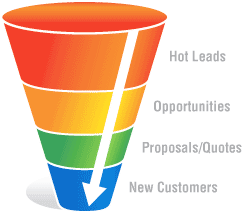
America’s Best Companies by Charles Cooper: Your business lives or dies on your sales and often that rides on the success of the sales call. The more of those that end in a handshake and a signature, the better your bottom line becomes. There is, however, no sure-fire method of scoring a sale each and every time. You can, however, shift the odds in your favor (or at least more in your favor) by planning for the sales call.
Mary Donato, president of Applied Principles and associate director of the Institute for the Study of Business Markets, writing for Sales and Marketing Management Magazine has looked into the issue of pre-sales call planning and has come up with several steps to follow to give you and your sales staff the best chance to succeed.
1. Decide what you want the client to decide or agree to once the meeting is over. How will you get them to agree to move on to the next step? What will you recommend at the end of the meeting?
2. What does the client have to believe about you, your company, your solution to move on to the next step? During your first meeting, the client needs to do most of the talking and you need to be an active listener. But you will need to ensure they believe you can be an appropriate provider to them.
3. What are key things that you want to know about the client? Ensure that you get a list of the client’s issues and know the most important items on that list. Research their company, don’t ask questions that are already answered on their website, but do ask thought-provoking, educated questions based on what you learn.
4. What are the potential objections? How will you respond? You should have a list of the common objections along with the appropriate responses. This can help you determine if your solution is a fit to the client’s problems or not.
5. Create an agenda for the meeting. Having an agenda provides meeting objectives to all involved. This is useful since decision-makers usually want someone who won’t waste their time and respecting their time (and yours) is key to building a successful business relationship.
6. Prior to the meeting, email the client with the agenda and the purpose of the call. Ask them if they have other objectives they would like to accomplish during the conversation and give them a chance to bring other, critical people into the meeting, or suggest others who you would like to include.
Planning is not fool-proof, and you may find that your plan needs to change on the fly once the meeting is underway, so be flexible. However, it is still your best roadmap to take you from that initial handshake to where you want to be—a sale.
Category: Sales & Marketing

Article Contributed by David Gruttadaurio
What would happen if you increased referrals by 20%, 40% or even 100% or more?
What would your business be like?
Could you expand your company?
Could you increase your rates?
Could you retire earlier and perhaps enjoy more of the good life?
Absolutely!
But, most businesses (both online of offline) will never experience any of these benefits of increasing their referrals.
Why Referrals Dry Up After a Month
Most businesses are simply out of sight and out of mind. They allow their customers to forget about them.
I know, it’s so unfair, especially after doing such a great job for them. But it’s a universal truth.
Life today moves at the speed of light. If you don’t consistently work to remain in the awareness path of your clients, you can be certain they will never remember you or your company.
The GOOD NEWS is this problem can be easily fixed by a customer newsletter.
The REALLY GOOD NEWS is that a monthly customer newsletter will also create massive referral action by your clients.
4 Ways to Get More Referrals with Newsletters
1. Educate clients and prospects. Most people who engage in newsletter marketing make the mistake of trying to pitch on every page. That’s fastest way to get your newsletter in the trash can. If you want more referrals, build a trusting relationship by offering real content with high informational value.
2. Write newsletters that get passed around. Boring content doesn’t get read, much less passed on to anyone. That means your content must be interesting and engaging… that means it shouldn’t be all about you. You may love your business, but don’t expect your customers to feel the same way. Your newsletter should include articles that inspire, inform and are fun to read. This is the ONLY WAY your newsletters will get passed around bringing you more referrals.
3. Get your newsletter out to as many as possible. If you follow my newsletter marketing system, people will read your newsletters as a publication. They will not see it as a marketing piece even though it really is. This makes a quality newsletter a great way to tell your story in all kinds of situations. So, hand out copies at sales calls, trade shows and seminars. Drop them off at realtors and doctors offices. Put them in envelopes when you pay bills. And make sure people can download a copy on your website, after they give you their contact information.
4. Thank referrers in your newsletters. A standard feature in every newsletter should be a thank you to the clients that have referred you to others. Realizing how important referrals are to your business will motivate other customers to refer you too.
The Bottom Line
You will not get referrals if you do not manage your existing customers properly.
Your existing customers are your best sales people. They already know the quality of your products and services. They will continue to call you and REFER you if they are reminded to do so. A monthly client newsletter provides this friendly reminder in an interesting and non-intrusive way.
Follow this advice and you’ll be light years ahead of the competition and enjoy a constant stream of referrals.
About the Author
David Gruttadaurio was tired of wasting money on marketing that didn’t work. So he searched for a marketing tool that would give him more clients for his cleaning business until he found newsletter marketing! Through print newsletters he was able to get more referrals and triple his sales. Now, discover how he got and retained more clients with his FREE “Profit Exploding Newsletter Secrets Report” at http://www.NewslettersMadeForYou.com

Article Contributed Joanne Black
We’ve been told that getting more sales is all about your “activity,” but is it?
Our job as salespeople is to move as many qualified prospects through the sales funnel as quickly as possible—leading to more sales, better clients, and more income.
The traditional sales funnel to attract new business has maintained the same structure for years. There’s a wide opening at the top and a skinny tube at the bottom. The traditional prospecting method crams as many prospects into the top of the funnel as possible, hoping that new clients will magically pop out of the other end. The only thing that mattered was sheer activity.
Today, I’m going to debunk the myth that sheer activity is the ONLY thing that matters along with two other myths that are holding you back from getting more clients now.
3 Sales Lead Generation Myths That Will Hold You Back From Closing More Sales
Myth #1 Sheer Activity is the Only Thing That Matters in Sales
Wrong! Of course, activity is still important, but what really matters is that you feed the right people into the funnel in the first place and nurture those prospects who have been referred to you. Then hasten their passage through the sales funnel. This will decrease the amount of time it takes to you close your sale.
Picture the funnel from the traditional “olden” days. If you just stuff as much as you can into the top of the funnel, it’s more likely that weeds, rocks, sand, and other debris will clog the opening and prevent the steady entry and flow of good business. Try pouring water in a funnel that is filled with debris. The water backs up and nothing moves through. Not a pleasing picture, and not functional business model. It’s certainly not one that fosters an environment for attracting new business.
Myth #2 Sales 2.0 Leads are Qualified
There’s so much that’s wrong about the traditional sales funnel, and it’s gotten worse in the Sales 2.0 world. It’s not a referral-marketing funnel. In the past, we were schooled to throw as many prospects in the funnel as we could find. For example, we were taught to get so-called leads from mailings, trade shows, advertising, networking, newsletters, and speaking. Now in the 2.0 world, we are taught to get so-called leads from blogging, videos, eBooks, free reports, press releases, eZines, affiliate traffic, RSS feeds, and email lists. We can now choose to waste our time by following up on these so-called leads.
I call the leads above “So-called leads” because these aren’t really leads.
They’re inquiries, possibly names—or people just interested in free stuff. Everyone likes free stuff. If we take the time to weed through all this trash, we might actually find a prospect. These people are just prospects. They’re not business referrals. And, they’re still not leads.
Myth #3 It’s Important to Sort “Leads”
We have to change how we talk about leads. Inquiries are not leads. People wanting free stuff are not leads. Neither are those “coveted” lists or files of names. Calling these “leads” borders on insulting.
Leads are people who:
- Are truly interested in talking directly to you about your products and services to see how you can help them
- Match the profile of your ideal client
- Have a budget
- Have a need that you can fulfill
- Are open to pursuing how you can help them attract new business.
Now that’s a qualified business referral.
The best leads are those you have received through a referral. When you receive a qualified referral, you are pre-sold. You have credibility and trust. Your sales time shortens. And, you ace out the competition. When you’ve been referred, you get a new client more than 50 percent of the time. Get more referrals and get these results.
So stop calling everyone and everything a lead. It’s is a waste of your valuable sales time. I’m not just splitting hairs over terminology. It is downright misrepresentation when companies position themselves as lead-generation experts. It sounds so good (so easy), so we jump. And that’s when we get our sales funnel clogged with trash instead of getting more referrals.
In this lagging and volatile economy, it’s easy to be lured by business which clogs our sales funnel. We can’t afford to attract the wrong kind of clients to our business. It’s like dumping trash in our sales funnel. A full funnel is only valuable if it’s filled with the kind of clients that are right for you – clients that are qualified and referred.
Think about it: What’s in your sales funnel?
About the Author:
America’s leading authority on referral selling and founder of No More Cold Calling, Joanne Black helps salespeople, sales teams, and business owners get more referrals and attract more business fast without increasing costs. Now, discover how to turn prospects into clients more than 50 percent of the time even during a down economy at http://www.nomorecoldcalling.com

Article Contributed by Guy Kingston
It might seem crazy to be talking about hiring – yes, hiring – more staff in a recession. Most companies are worrying about having to lay people off.
It might seem doubly insane, in one sense at least, to be talking of hiring in the sales department of all places. After all, when you have to make cuts, you must make them first of all in the variable costs rather than the fixed costs of a business – and a properly run sales department should be the ideal example of a variable cost. It should cost more when sales are high and less when they are low. Indeed, in theory, the perfect sales department would be based entirely on commission so that it would cost nothing if there were no sales, and expenditure would rise in direct proportion with income.
The reality is that sales demand some prior investment. Even the best salesmen are reluctant to rely entirely on commission. They know their value to a business and are usually confident enough to demand a basic salary up front. The only people prepared to work for commission only are the desperate. It is therefore one of several paradoxes in sales that those who are most likely to be able to live on commission alone are the very people who are most likely to demand more than just commission.
Since you do not want your business to be represented by losers – even losers who cost nothing up front – you need to reconcile yourself to paying a basic salary to your sales staff before they sell anything.
So, in practice, the sales department is not the variable cost that it should be in theory.
Yet it is still a cost, and in a recession, one should cut costs – right?
Not necessarily. A business should always be looking for opportunities to cut surplus expenditure in order to maximise its cost effectiveness, and its competitiveness in terms of price. This should be a constant discipline and it is obviously particularly important in time of recession.
However, it should be equally obvious that it is false economy to cut expenditure that is necessary for the proper operation of the business. After all, the only business with zero expenditure is a business that is not doing business.
So simply reducing costs is not the correct response to a recession. It may be necessary in the short term, but in the longer term it can only lead to oblivion.
The alternative to decreasing costs is increasing income. In fact, a good recession strategy will contain elements of both.
Increasing income means investing more in sales. This may sound risky but it is actually more risky to do nothing. In a recession competition becomes tighter. You must fight harder for every customer. As business becomes ever more ruthless, you must fight to keep your customers and to pick up any new customers who might still have money to spend. To invest less in sales at such a time means losing customers to those who invest more.
Remember that there are new customers to be found even in a recession. When a company goes bust, its customers do not die suddenly of neglect. Most are still alive, still solvent, and still spending. They will probably be looking for a new supplier of whatever the fallen company provided. That is an opportunity for its competitors.
On the supply side, recession is also an excellent time to pick up experienced sales staff from bankrupt competitors. Such people usually bring with them address books full of former customers and other useful contacts.
Of course, spending more money on sales staff in a recession is a risk. Yet all investment in business is a risk. Recessions do not alter the rules of the game. They simply makes the odds tighter. Competitors become more competitive, and the chances of failure increase – but so do the rewards of success for those who keep their nerve.
About the Author
Guy Kingston produces and presents the Mind Your Own Business podcast, offering free business advice to entrepreneurs and business owners. As well as audio podcasts there are more articles like this, compelling videos and a must-read blog. All at www.myobpod.com or you can network and join in discussions on the MYOB Facebook group.

Article contributed by Joanne Black
It’s hard enough to get more prospects and new clients during a booming economy when people have money to spend. When the global economy takes a nosedive and freefalls fast, it’s 100 times harder to get prospect to talk to us.
So, how can you get more referrals and more NEW clients in a lagging economy?
It’s straightforward: The answer to getting more referrals and more new clients during any economic situation is to ask.
How many of your clients have you asked for referrals? When I ask this question to salespeople, the usual answer is “not many” or “hardly any.”
For example, I was working with the president of a consulting firm. I asked him how many clients he had—counting all the people he worked with, not just the number of companies. He told me 295. Then I asked him: with how many of the 295 did he have excellent relationships.
His answer: 60.
I then asked him how many of the 60 he had asked for referrals.
Silence.
Sixty of his best, most valued clients were just sitting there. These clients were an underleveraged source of referrals that could be bringing in more clients.
If you’re not inviting your current clients to be part of your sales team, you’re leaving money on the table – every single day. If you ask them, they’ll be happy to refer you. But, you have to ask.
If you’re a good salesperson, you probably have at least 100 people on your prime contact list. These are people you could phone, and they would return your call. If only 20 percent referred you, you’d have 20 new prospects to satisfy. Once you satisfy them and once you actively cultivated relationships with them, they can become part of your “sales team.”
Can you see where this could lead, and how much business that could generate?
Real Proof Why You Should Ask Your Clients for More Referrals
In a survey of its best clients, a major brokerage firm asked: Would you be willing to refer your stockbroker?
The survey results: A whopping 84 percent of its best clients would be willing to refer their stockbroker. Eighty-four percent.
The firm asked brokers: What percent of the time are you asking your clients for referrals?
The answer: Only 15 percent.
Their clients were absolutely willing to refer them, but the brokers were not asking.
You can easily see how a fabulous opportunity was overlooked. Think about how much money the brokers were leaving on the table. Those referrals could easily have generated millions of dollars in revenue for the firm, if they’d been maximized.
The Hard Fact: Your Clients Will Help You Get More Prospects and New Clients – But You Need to Ask
The hard fact is most clients think of us only when they need us. It’s up to you to get them thinking about you between orders. Your clients are not going to automatically refer you. You must constantly remind them that you exist, so when a referral opportunity arises, you’re the one who gets it.
The clients you serve well – the ones who know you, like you, and trust you -truly want you to be successful. After all, they know what you do and they’ve received measurable business results from your solutions. Referring you will make them look good to their customers and business partners.
So are you now ready to get more referrals, prospects and clients right now?
Top 5 Tips to Help You Get More Referrals During a Global Economic Slowdown
1. Review your database and gather information about your current clients. Find out:
– What percent of your current clients were referred?
– How profitable are your current clients?
– Have they bought additional products from you?
– How often have you contacted them?
– How many have referred you to other clients?
2. Put a plan in place to check in with your clients and find out what they need.
3. Make a note about why they like working with you.
4. Ask for ways to improve.
5. Invite them to help you build your business through referrals and ask them to refer you.
Your current clients are going to be your best source of referrals. They’re just waiting for you to ask.
It’s time to ask. What are you waiting for?
About the Author:
America’s leading authority on referral selling and founder of No More Cold Calling, Joanne Black, helps salespeople, sales teams, and business owners get more referrals and attract more business fast without increasing costs. Discover how to turn prospects into clients more than 50 percent of the time, even during a down economy, with her Recession-Proof Your Business Emergency Kit at: http://www.nomorecoldcalling.com/products.html